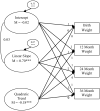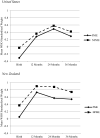Cross-national comparison of prenatal methamphetamine exposure on infant and early child physical growth: a natural experiment
- PMID: 23943149
- PMCID: PMC3947752
- DOI: 10.1007/s11121-013-0431-5
Cross-national comparison of prenatal methamphetamine exposure on infant and early child physical growth: a natural experiment
Abstract
The current study seeks to compare the effects of prenatal methamphetamine exposure (PME) on infant and child physical growth between the USA and New Zealand (NZ). This cross-national comparison provides a unique opportunity to examine the potential impact of services provided to drug using mothers on child health. The longitudinal Infant Development, Environment and Lifestyle study of PME from birth to 36 months was conducted in the USA and NZ. The US cohort included 204 children with PME and 212 non-PME matched comparisons (NPME); the NZ cohort included 108 children with PME and 115 NPME matched comparisons. Latent growth curve models were used to examine effects of PME, country of origin, and the country × PME interaction on growth in length/height and weight. In regard to length/height, PME and country of origin were associated with initial length and growth over time. There was also a significant interaction effect, such that children with PME in the USA were shorter at birth than children with PME in NZ after controlling for other prenatal exposures, infant set, socioeconomic status, and maternal height. In regard to weight, there was only an effect of country of origin. Effects of PME on infant and child growth were shown to differ across countries, with exposed children in NZ faring better than exposed children in the USA. Implications for prevention programs and public policy are discussed.
Figures






References
-
- Acuff-Smith KD, Schilling MA, Fisher JE, Vorhees CV. Stage-specific effects of prenatal d-methamphetamine exposure on behavioral and eye development in rats. Neurotoxicology & Teratology. 1996;18:199–215. - PubMed
-
- Bentler PM. Comparative fit indices in structural models. Psychological Bulletin. 1990;107:238–246. - PubMed
-
- Billing L, Eriksson M, Jonsson B, Steneroth G, Zetterström R. The influence of environmental factors on behavioural problems in 8-year-old children exposed to amphetamine during fetal life. Child Abuse & Neglect. 1994;18:3–9. - PubMed
Publication types
MeSH terms
Substances
Grants and funding
LinkOut - more resources
Full Text Sources
Other Literature Sources
Medical
Research Materials

